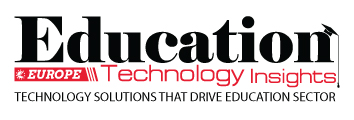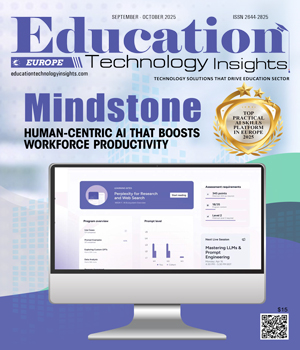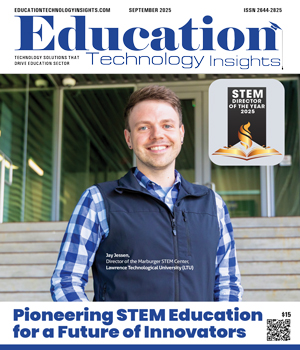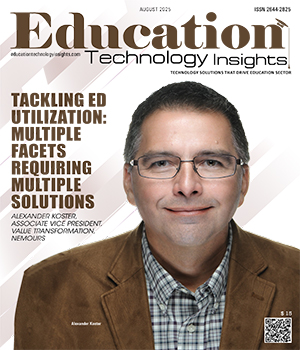THANK YOU FOR SUBSCRIBING
Be first to read the latest tech news, Industry Leader's Insights, and CIO interviews of medium and large enterprises exclusively from Education Technology Insights
Reimagining Education in the Age of AI: From Information Scarcity to Abundant Intelligence
Raymond Uzwyshyn, Ph.D. MBA MLIS AUL & Director, Research and Technology Services, University of California, Riverside Libraries
 Raymond Uzwyshyn, Ph.D. MBA MLIS AUL & Director, Research and Technology Services, University of California, Riverside Libraries
Raymond Uzwyshyn, Ph.D. MBA MLIS AUL & Director, Research and Technology Services, University of California, Riverside LibrariesA recent academic forum exchange captures the transformation reshaping education today. A professor reflected: "Students are always using AI to complete assignments. If they're not reading, researching, or memorizing what are we teaching or assessing? What is the purpose of university education anymore?"
These questions all illustrate education's pivotal moment. Students have anticipated workforce needs by embracing AI while circumventing traditional educational methods. Recent graduate face delayed employment. Just as the printing press shifted paradigms and transformed learning from oral tradition to literacy, AI now necessitates a profound reimagining of how we teach, learn, and transmit knowledge across all educational levels.
The Great Paradigm Shift
Traditional educational systems emerged during earlier periods of information scarcity. When books were rare and knowledgeable teachers limited, education emphasized information transfer, memory, and retention. This scarcity paradigm shaped fundamental practices for hundreds of years. Lectures broadcast information for the new ‘knowledge worker class’. Memorization functioned as knowledge storage. Testing provided retention, assessment and verification.
We now inhabit an era of paradigm-shifting information abundance. AI systems instantly access and process virtually unlimited information. They also synthesize it in ways that often complement or exceed human performance in specific domains. This shift changes everything significantly. Information itself holds diminishing value. Meanwhile, evaluation, contextual and creative application become paramount in this new period. The 19th century industrial education model optimized for standardized information transfer is now misaligned with our AI-integrating world.
Understanding AI's Educational Impact
AI transforms education by enhancing information synthesis, personalizing learning and makes rote memorization and standardized student testing obsolete. Unlike previous technologies that extended our physical capabilities, AI extends cognitive processes themselves. This transforms education from knowledge transfer to developing human-AI collaboration. Katherine Hayles describes "human-machine symbiosis" as the distributed cognitive system where human and artificial intelligence become complementary partners rather than competitors. This represents a fundamental shift requiring new educational philosophies.
Redesigning Education by Level
Educational transformation must begin with young learners developing foundational AI literacy through age-appropriate activities. Literacy was defined as reading and writing in the early 17th century. Digital literacy emerged in the late 20th century as the ability to create web content, podcasts, or digital videos, AI literacy represents fluency in how to work with and utilize AI systems effectively in the 21st century.
“The goal is developing human potential more fully by outsourcing certain cognitive functions while focusing on uniquely human capabilities. These include creativity, ethical reasoning and interpersonal connection”
Students explore pattern recognition through AI games. These activities build native AI fluency beginning with play with AI while maintaining critical awareness. The smartphone has become our essential computing device. It needs implementation with AI empathic voice interfaces from the earliest instruction levels for young children to engage in conversations with time for reflective discussions. Human teachers and AI can tutors work together in the classroom to facilitate this learning.
As students mature into middle school, curriculum should integrate AI tools within project-based learning that addresses authentic problems. This includes AI-assisted data analysis and combining subject knowledge development while building collaboration and community skills. Students need explicit meta-learning strategies. They require frameworks for determining when AI assistance enhances learning versus when independent thinking needs to develop. Understanding metacognition in both humans and AI helps students grasp intuitively how AI agents communicate with each other and with humans through dialogue .
High school education requires each discipline to thoughtfully incorporate AI tools while explicitly discussing how these technologies transform field practices. Literature classes might blend AI text analysis and essay reviewing with traditional close reading. History courses could use AI to analyze primary sources alongside critical evaluation of AI interpretations. Assessment must shift from standardized testing to portfolio-based evaluation that demonstrates individual capabilities and effective human-AI collaboration.
Higher education and universities must move beyond traditional departmental silos toward interdisciplinary problem-solving and face the most radical need for restructuring. AI serves as connective tissue across knowledge domains, enabling enhanced discovery, insights, and invention. Universities and high schools must develop new forms of expertise focused on directing, evaluating, and improving AI outputs rather than competing with AI on information processing or memorization. This new workforce will need very sophisticated ability to effectively guide information processing systems while maintaining critical judgment about their outputs and implications.
Implementation and Opportunities
Successfully implementing this vision requires comprehensive faculty retraining, infrastructure development, and assessment reform. Teachers must shift from content expertise to process facilitation. Educational institutions need universal connectivity and equitable AI tool access. Assessment systems must shift from measuring what students know to personalization and evaluating how effectively they apply knowledge with AI assistance.
The AI transition creates opportunities for educational liberation. It frees human learning from industrial age assembly line education paradigms while expanding possibilities for creativity and critical thinking. The goal: develop human potential by outsourcing memory and storage while focusing on uniquely human innate capabilities. These include creativity, ethical reasoning, emotional intelligence and interpersonal connection. This collaborative approach results in meaning-making, discovery, and joy in the learning and research process.
Students entering school today will graduate into a world where AI integration and collaboration spans all sectors. Their education must prepare them for tomorrow's landscape where human value lies in capabilities complementary to artificial intelligence. This transformation offers the chance to address education's evolving purpose. AI Literacy involves thoughtfully redesigning learning to cultivate distinctly human capabilities while leveraging AI as a profound collaborative partner. The time for this educational renaissance to begin is now.
Read Also
Reimagining Education in the Age of AI: From Information Scarcity to Abundant Intelligence
New, Valuable and Realized: Cultivating Innovation in K-12 Education
Securing the Future with AI
Creating Practical Pathways for Global Education Change
Delivering Exemplary Customer Service in K-12 Technology: Auditing the Experience for Teachers, Students, and Parents
Striving for Impactful and Sustainable Professional Learning

I agree We use cookies on this website to enhance your user experience. By clicking any link on this page you are giving your consent for us to set cookies. More info

However, if you would like to share the information in this article, you may use the link below:
www.educationtechnologyinsightseurope.com/cxoinsights/raymond-uzwyshyn-nid-3489.html






















